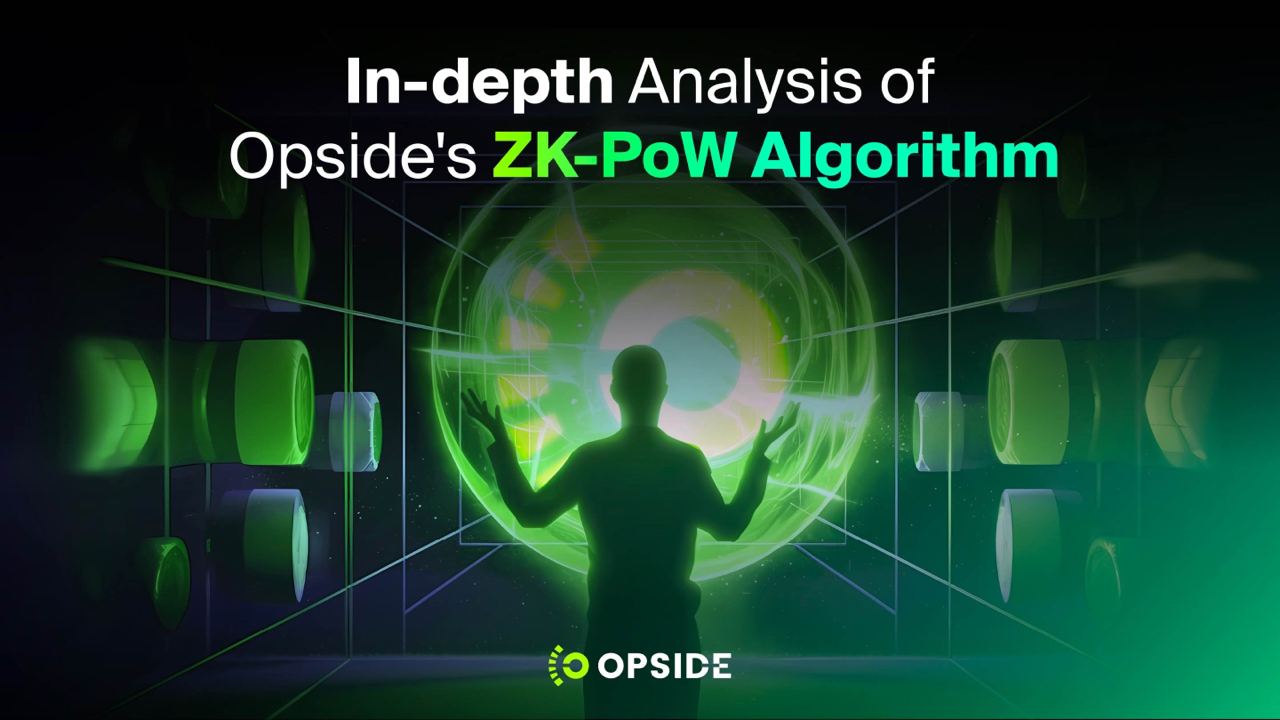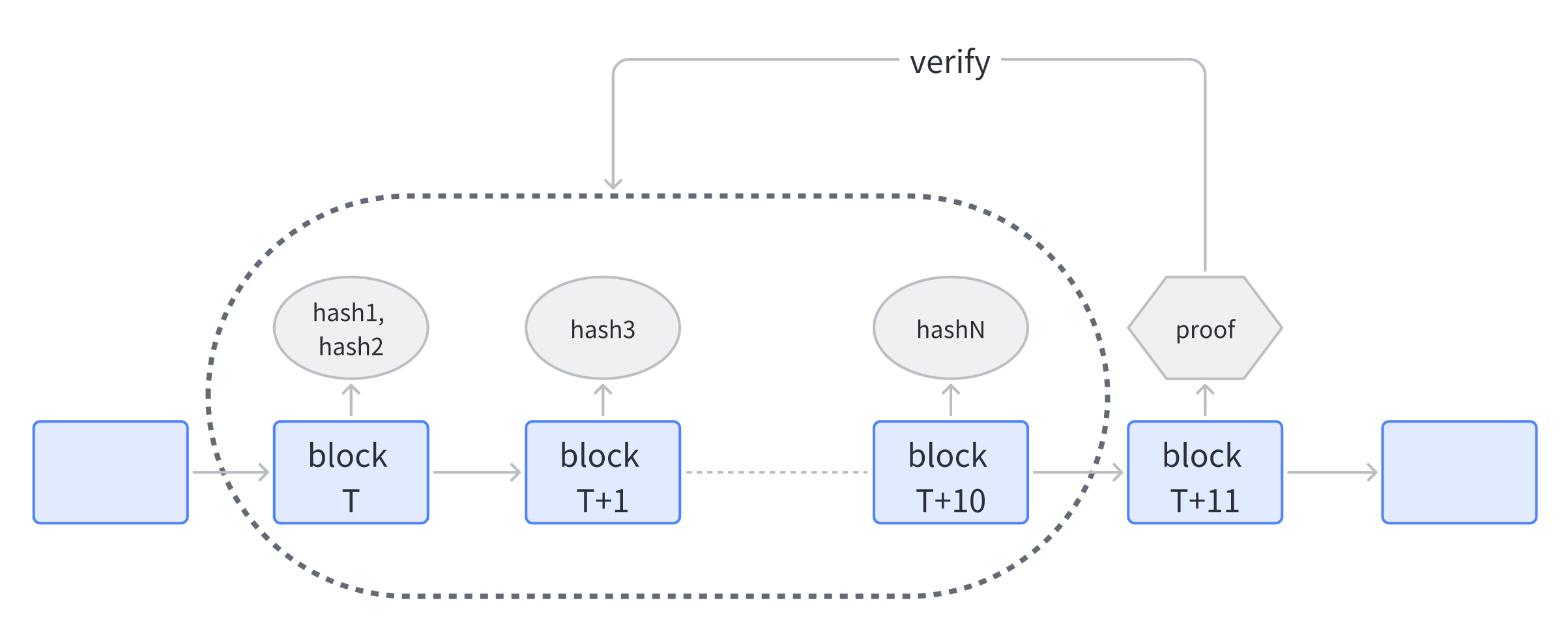Understanding Opside’s ZK-PoW Algorithm in One Article
Opside's ZK-PoW Algorithm Explained in One Article 
TL;DR
Opside’s ZK-PoW algorithm has the following advantages:
- A market-based ZK computing power pricing mechanism that can be used not only for scalability (ZK-Rollup), but also for AI (ZKML) in the future
- Provides a massive computing power platform for the upcoming ZK-Rollup (especially zkEVM) outbreak; also provides new mining scenarios for a large number of idle miners
- The two-phase commit algorithm of ZKP provides a standard decentralized Prover mechanism for ZK-Rollup
- Optimized ZKP calculation and submission mechanism, which improves the efficiency of generating ZKP by 80%
Why do we need a ZK computing power PoW algorithm?
Currently, multiple ZK-Rollups are running on the Ethereum mainnet, including Polygon zkEVM and zkSync era. However, most ZK-Rollup projects currently do not have a decentralized prover. For example, the beta mainnet of Polygon zkEVM relies on a trusted aggregator to submit ZKP, and zkSync era is also similar.
- Hong Kong’s new regulations on virtual assets are officially in effect, marking a historic moment for Web3 in Hong Kong.
- Will Sam bring surprises to Web3 from ChatGPT to WorldCoin?
- Exploration of Legal Issues Arising from “Digital Collections” in Practice
When there are not many ZK-Rollups, centralized prover is feasible. However, with the maturity of ZK scalability technology, especially the gradual landing of zkEVM technology in the next one to two years, the number of ZK-Rollups will increase significantly. In the case of massive ZK-Rollups, centralized prover will also cause many problems:
- First of all, the cost of prover is high, and specialized equipment and machine rooms are required. Not every ZK-Rollup operator has the ability to maintain a centralized prover cluster. Therefore, we need professional miners to undertake the computing power needs of massive ZK-Rollup in the future
- Secondly, if there is only one prover, a single node failure will cause the entire ZK-Rollup transaction to be unconfirmed. We need a decentralized Prover mechanism to encourage multiple miners to participate in the calculation of a ZKP at the same time and obtain the corresponding rewards.
- Finally, we need a standardized ZKP optimization algorithm to improve overall hardware efficiency.
Opside ZK-PoW Algorithm
As a highly decentralized public chain, Ethereum has become very crowded and gas fees are extremely expensive. Many Web3 applications, especially financial derivatives, games, social networks, etc., need to migrate to layer 2 or other public chains. In fact, it is not difficult to provide a high-performance and low-gas execution environment, and some centralized solutions can easily achieve this. The difficult part is how to maintain a high degree of decentralization while ensuring high performance and low gas at the same time.
In Opside’s design, each Web3 application can have an exclusive ZK-Rollup, and can freely choose the base chain. Currently, Opside supports 4 base chains, which are Ethereum, Opside, BNB chain, and Polygon. That is to say, developers can choose to deploy their own ZK-Rollup on these 4 public chains. In order to support the huge demand for hardware resources brought by the large number of ZK-Rollups, Opside also provides a unified ZKP computing power market, which encourages Miners to generate ZKP for these ZK-Rollups.
PoW Reward Allocation Mechanism
Opside adopts a hybrid consensus of PoS and PoW. The PoS part is based on the consensus improvement of ETH2.0. Therefore, Opside will have more than 100,000 validators to provide massive data availability while maintaining a high degree of decentralization.
In the Pre-Alpha testnet phase, according to the PoW algorithm, each Rollup in an Opside block will submit a sequence according to certain rules. All sequences are divided into the PoW reward of the current block based on the current Rollup slot registration quantity and the number of batches included. Of course, it is possible that some rollups do not submit sequences in some blocks, so the actual PoW inflation may be lower than expected.
Miners can freely choose to participate in the ZKP calculation of one or more Rollups. In the future, each sequence will estimate the workload based on the corresponding ZK-Rollup type, the number of Rollup transactions included, gas usage, etc., and price different sequences differently.
In order to avoid malicious behavior related to Miners, Miners need to register in a special system contract and pledge tokens. Miners need to pledge the corresponding tokens for a Rollup in the system contract before they can submit ZKP for that Rollup. The reward obtained by Miners for submitting ZKP will also be allocated based on the proportion of the amount pledged, thereby avoiding malicious behavior of Miners submitting ZKP multiple times. For more details, please refer to Opside Tokenomics.
ZKP’s Two-Step Submission Algorithm: Standard Decentralized Prover Mechanism
In order to encourage multiple miners to participate in a ZKP calculation task, Opside has proposed a two-step submission ZKP verification mechanism. The PoW reward share corresponding to a ZKP will be allocated to the submitter of the valid ZKP according to certain rules, i.e., the miner.

- Submit proofhash: Within a time window, multiple miners are allowed to participate in the zero-knowledge proof calculation for a certain sequence. After calculating the proof, each miner does not directly submit the original proof, but calculates the proofhash (proof/address) and submits the proofhash to the contract.
- Submit ZKP: After the time window, the miner submits the original proof and verifies it with the previously submitted proofhash. Miners whose verification passes can receive PoW rewards, and the reward amount is allocated in proportion to the miner’s pledge amount. For more details, please refer to ZKP’s Two-Step Submission Algorithm.
Optimized ZKP Generation Algorithm: 80% Efficiency Improvement for Miners
When Rollup’s smart contract verifies ZKP, submitting the original proof data may trigger on-chain attack behavior. To prevent malicious attacks, ZK-Rollup often needs to do extra work to hide the original proof data. One solution is that the ZKP submitted by the miner contains the aggregated result of the miner’s address. The two-step submission algorithm of ZKP proposed by Opside adopts the mode of submitting first and then verifying, and no longer requires similar unnecessary aggregation calculations of proof and address.
In addition, in some open-source zkEVMs, ZKP calculation and submission are serial. When ZK-Rollup submits a large number of sequences, miners cannot calculate multiple ZKPs at the same time. In Opside, the two-step submission algorithm of ZKP realizes parallel calculation of ZKP and serial submission, allowing miners to execute multiple ZKP generation tasks at the same time, greatly accelerating the efficiency of ZKP generation.
The Opside team has also optimized the ZKP recursive aggregation algorithm, fully improving the utilization of machine resources in the cluster and further improving the calculation speed of ZKP.
In the actual stress testing environment, miners have a machine cluster composed of 20 128-core CPUs and 1TB RAM, and the stable transaction is about 27.8 TPS in about 40 minutes. Under the same conditions, Opside reduced the average confirmation time of transactions from about 5-6 minutes to about 3 minutes, and the efficiency of ZKP generation was improved by about 80%. In the future, with the participation of more ZK-Rollups and miners, the demand and supply scale of the ZK computing power market will further expand, and the efficiency improvement brought by Opside’s PoW algorithm will be more prominent.
Summary
Opside’s ZK-PoW algorithm creatively defines a market-based ZK computing power pricing mechanism. This computing power market provides a massive computing power platform for the upcoming ZK-Rollup (especially zkEVM) explosion, as well as a new mining scenario for a large number of idle miners.
The two-step submission algorithm of ZKP provides a standard decentralized Prover mechanism for ZK-Rollup, encouraging more miners to provide stable and continuous ZKP computing power. At the same time, the optimized ZKP calculation and submission mechanism improves the efficiency of generating ZKP by 80%.
In the future, the application scenarios of Opside’s PoW mechanism can be easily expanded, not only for expansion (ZK-Rollup), but also for AI (ZKML).
We will continue to update Blocking; if you have any questions or suggestions, please contact us!
Was this article helpful?
93 out of 132 found this helpful
Related articles
- What is the current state of development of on-chain government bonds? We have studied 5 agreements.
- Interpretation of Trust Minimization Middleware by Distributed Capital Researcher: Consensus Verification and Bridging
- Yuga Labs May Data Report: The Darkest Moment for NFT Industry Leader?
- Celestia: Modular Data Availability for OP Stack
- Encrypted wallet developer Demox Labs secures $4.5 million in funding led by HackVC
- Circle will launch native USDC on Arbitrum on June 8th.
- Unprecedented demand for AI computing power, what is the role of Web3?





